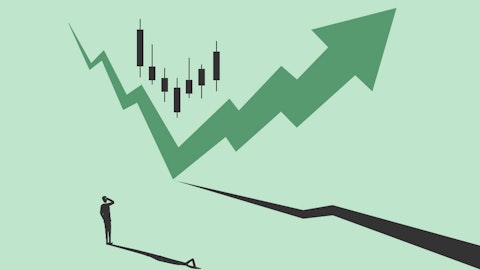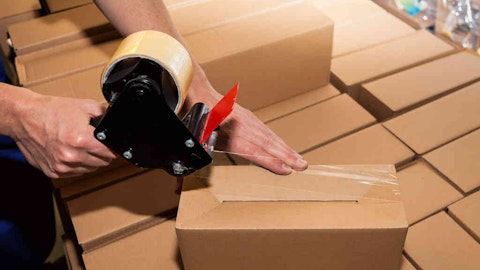Mike Roman: Yes. Andy, as I said 3 months ago, we’ve been looking at everything we do as we come through the pandemic, come through the supply chain disruptions even face into the outlook for the year and our markets as we move ahead. So the actions that we’ve come to, they have been something that we’ve been very deliberate about thinking through. They are taking from learnings about what worked well and areas that we know we can improve. So it starts with a pretty strong basis. We’re confident that these are the right actions about positioning us for growth and profitability as we go forward. And it will help us navigate – as Monish just laid out, help us navigate some of the challenges and uncertainty we have in the current market.
So our focus is – as your question kind of indicated, our focus is on executing successfully. And that’s – these are significant changes. We’re confident we’ve got the right focus. We’ve made some leadership changes to really ensure that we have our leadership focused on successfully making these improvements. And I think that this is the next step for us. We believe and we’re confident these will be the steps that really help improve our performance in our businesses and our supply chain. And as the second part of your question focused on, it’s about improving our costs and margins. Reducing our costs and improving our margin performance gives us a position to be successful in the future, leverage our innovation to create differentiated value with customers and deliver that to the bottom line performance that we expect both in terms of margins and cash flow.
So it does position us for confidence in being able to do that as we go forward that incremental margin from our differentiated innovation. So yes, that’s – it’s exactly the reason and confident we’re positioned at the right – with the right strategies in place.
Andrew Kaplowitz: Thank you.
Operator: Our next question comes from Stephen Tusa with JPMorgan Securities. You may proceed with your question.
Stephen Tusa: Hi, good morning.
Mike Roman: Good morning, Steve.
Monish Patolawala: Good morning, Steve.
Stephen Tusa: So just on this restructuring cost, can you maybe just give us a quarterly cadence on the costs and then the savings? And I mean getting half of the savings this year, that seems like a pretty quick payback on half the spending. Like is there anything unique to this program that would have an accelerated payback like that? It seems like a one-for-one on a quarterly basis, which is pretty fast.
Monish Patolawala: Yes. So I’ll just start again, Steve. It’s $700 million to $900 million. We expect half of that to be incurred in 2023 and $175 million to $250 million to be incurred in the second quarter. The benefits of that program is also half in 2023, very little in 2Q. So the benefits actually show up in the second half. The reason the benefits are stronger than you would have normally seen as not all of these costs are just people-related costs. We are taking a lot of other costs out from the center of the company, we’re reducing rooftops, et cetera, which allow us to exit some of these cost structures faster, and that’s why you get a better payback.
Stephen Tusa: And so as far as the cadence of the charges, is there – is it – should we assume that they are spread throughout 3Q and 4Q and additionally with the savings, 3Q and 4Q?
Monish Patolawala: Right now, I would just focus on 2Q and the total year. And we will update you, Steve, as we get through the announcements today and work through all the people-related costs and work through the rules and regulations in various countries. I would just focus on total year-end and 2Q.
Stephen Tusa: Okay. And then what was – as far as like the go-to-markets are concerned and how you’re changing things, what was the catalyst for this? What did you see in the business that you thought you needed to improve on from a go-to-market perspective with all these changes that you were talking about? It seems like some pretty significant initiatives from that perspective and a change in the way you guys have done business historically. What was the catalyst for that? What did you see that you didn’t like?
Mike Roman: Yes. I think the catalyst is really the learning and experience that we’ve gone through over the last few years. We put in place a business-led model really around our go-to-market models. We also put in place a global supply chain model that was end-to-end managed in one consistent model across the world. And we’ve been operating that through the pandemic, through the supply chain disruptions. Our businesses are learning, the go-to-market models that we have in place, we’re learning how to optimize those. And I would say we’re – we’ve gotten to a point when we look at where our markets are going in the future, where we want to invest, how we want to operate best to serve our customers. It’s really a learning – more of a learning over that experience than a catalyst.
There is a catalyst, that’s to position ourselves as we take action now for the future, make sure that we are stepping into the changes that will both drive the performance in the near-term and also position us for the future. So the learning was really – and I think the clear view of what we can do to improve in the go-to-market models and also in our supply chain that is really, like I said, giving us the strong focus on the actions that we’re taking and announcing today.
Monish Patolawala: Can I just add one more, Steve? As – I’ve always said this before, digital is a multiplier for 3M. And some of the digital capabilities that we have built over the last few years allows us to serve customers better. For example, Mike mentioned one of the areas where we are relooking at how we go to market in certain countries where in the past, we have had a full roof stop and a full cost structure, and now we’re going to work through our partnerships of third-party distributors, leverage our digital capabilities, leverage our export capabilities. And that also allows us to reduce cost while making sure we still continue to take care of customers in those countries.
Stephen Tusa: Great. Okay, thanks for the color.
Operator: Our next question comes from Scott Davis with Melius Research. You may proceed with your question.
Scott Davis: Hey, good morning, Mick and Monish, Bruce.





